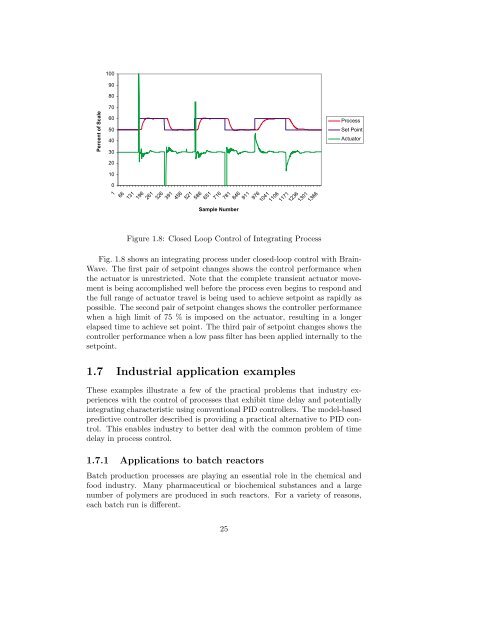Adaptive Predictive Regulatory Control with BrainWave - Courses ...
Adaptive Predictive Regulatory Control with BrainWave - Courses ...
Adaptive Predictive Regulatory Control with BrainWave - Courses ...
You also want an ePaper? Increase the reach of your titles
YUMPU automatically turns print PDFs into web optimized ePapers that Google loves.
Percent of Scale<br />
100<br />
90<br />
80<br />
70<br />
60<br />
50<br />
40<br />
30<br />
20<br />
10<br />
0<br />
1<br />
66<br />
131<br />
196<br />
261<br />
326<br />
391<br />
456<br />
521<br />
586<br />
651<br />
Sample Number<br />
716<br />
781<br />
846<br />
911<br />
976<br />
1041<br />
1106<br />
1171<br />
1236<br />
1301<br />
1366<br />
Figure 1.8: Closed Loop <strong>Control</strong> of Integrating Process<br />
Process<br />
Set Point<br />
Actuator<br />
Fig. 1.8 shows an integrating process under closed-loop control <strong>with</strong> Brain-<br />
Wave. The first pair of setpoint changes shows the control performance when<br />
the actuator is unrestricted. Note that the complete transient actuator movement<br />
is being accomplished well before the process even begins to respond and<br />
the full range of actuator travel is being used to achieve setpoint as rapidly as<br />
possible. The second pair of setpoint changes shows the controller performance<br />
when a high limit of 75 % is imposed on the actuator, resulting in a longer<br />
elapsed time to achieve set point. The third pair of setpoint changes shows the<br />
controller performance when a low pass filter has been applied internally to the<br />
setpoint.<br />
1.7 Industrial application examples<br />
These examples illustrate a few of the practical problems that industry experiences<br />
<strong>with</strong> the control of processes that exhibit time delay and potentially<br />
integrating characteristic using conventional PID controllers. The model-based<br />
predictive controller described is providing a practical alternative to PID control.<br />
This enables industry to better deal <strong>with</strong> the common problem of time<br />
delay in process control.<br />
1.7.1 Applications to batch reactors<br />
Batch production processes are playing an essential role in the chemical and<br />
food industry. Many pharmaceutical or biochemical substances and a large<br />
number of polymers are produced in such reactors. For a variety of reasons,<br />
each batch run is different.<br />
25

















